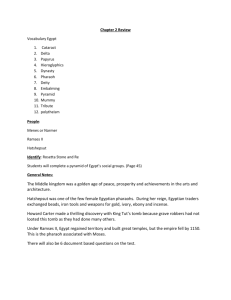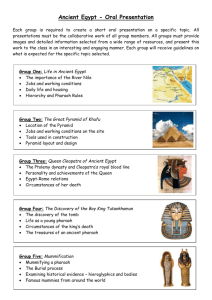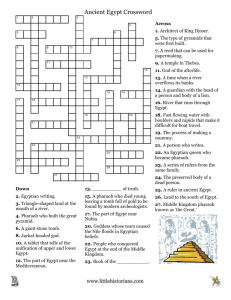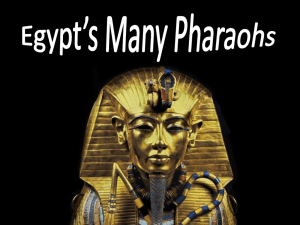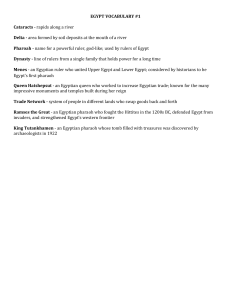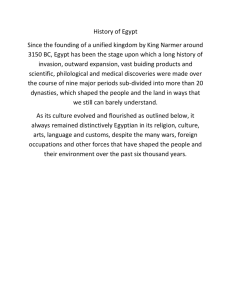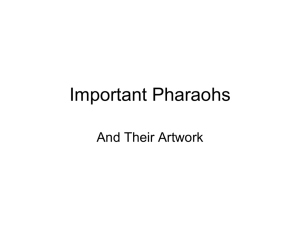Egyptian Art
advertisement
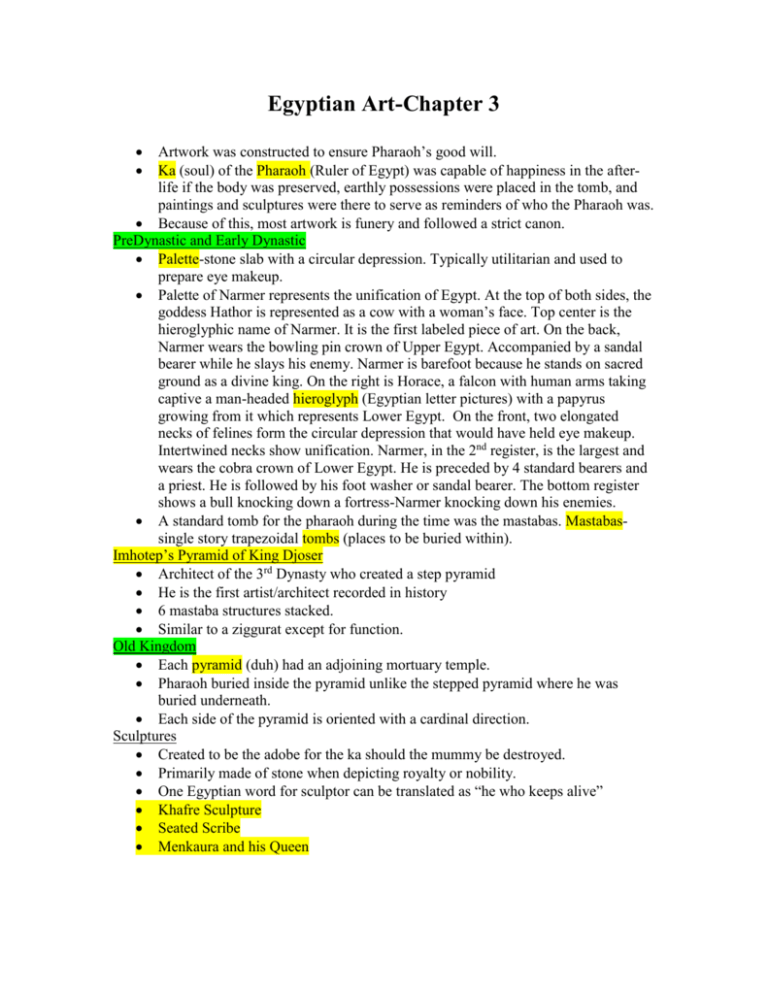
Egyptian Art-Chapter 3 Artwork was constructed to ensure Pharaoh’s good will. Ka (soul) of the Pharaoh (Ruler of Egypt) was capable of happiness in the afterlife if the body was preserved, earthly possessions were placed in the tomb, and paintings and sculptures were there to serve as reminders of who the Pharaoh was. Because of this, most artwork is funery and followed a strict canon. PreDynastic and Early Dynastic Palette-stone slab with a circular depression. Typically utilitarian and used to prepare eye makeup. Palette of Narmer represents the unification of Egypt. At the top of both sides, the goddess Hathor is represented as a cow with a woman’s face. Top center is the hieroglyphic name of Narmer. It is the first labeled piece of art. On the back, Narmer wears the bowling pin crown of Upper Egypt. Accompanied by a sandal bearer while he slays his enemy. Narmer is barefoot because he stands on sacred ground as a divine king. On the right is Horace, a falcon with human arms taking captive a man-headed hieroglyph (Egyptian letter pictures) with a papyrus growing from it which represents Lower Egypt. On the front, two elongated necks of felines form the circular depression that would have held eye makeup. Intertwined necks show unification. Narmer, in the 2nd register, is the largest and wears the cobra crown of Lower Egypt. He is preceded by 4 standard bearers and a priest. He is followed by his foot washer or sandal bearer. The bottom register shows a bull knocking down a fortress-Narmer knocking down his enemies. A standard tomb for the pharaoh during the time was the mastabas. Mastabassingle story trapezoidal tombs (places to be buried within). Imhotep’s Pyramid of King Djoser Architect of the 3rd Dynasty who created a step pyramid He is the first artist/architect recorded in history 6 mastaba structures stacked. Similar to a ziggurat except for function. Old Kingdom Each pyramid (duh) had an adjoining mortuary temple. Pharaoh buried inside the pyramid unlike the stepped pyramid where he was buried underneath. Each side of the pyramid is oriented with a cardinal direction. Sculptures Created to be the adobe for the ka should the mummy be destroyed. Primarily made of stone when depicting royalty or nobility. One Egyptian word for sculptor can be translated as “he who keeps alive” Khafre Sculpture Seated Scribe Menkaura and his Queen Ti Watching a Hippopotamus. 5th Dynasty. Scenes depicted associated with a provision of the ka in the after-life. Success in hunt symbolized the triumph of good over evil. High relief-comes far off the stone but is not completely sculpture in the round. Is usually still solid stone on the back. Middle Kingdom 2150 BCE. Egyptian people began to question the Pharaoh’s power and Egypt was in civil unrest for more than a century. Rock Cut Tombs Most widely used burial method of the middle kingdom. They largely replaced mastabas. Hollowed out of cliffs with a shallow columnar porch/vestibule which led into a columned hall then into the burial chamber. Columns had no real purpose. Walls were decorated with reliefs and paintings and sculptures were set into the walls. New Kingdom Hatshepsut: Her husband Thutmose II died and since she and he had no male heirs his 12 year old son by another wife was named heir. Hatshepsut was named regent while he was underage but eventually proclaimed herself pharaoh and ruled for two decades. Mortuary temple-3 colonnaded terraces connected by ramps. Pillars are rectangular. Terraces would have held gardens. Reliefs depict her from birth (Daughter of Amen-Re) to coronation. 1st great tribute to a woman’s achievement in art history. Lots of statues were created by later destroyed by Thutmose III. She is represented as a male in many of her statues. Temple of Ramses II Rock cut tomb 4 colossal images of himself on the façade. Interior housed 32 foot pillars of Ramses II as Osiris-the god of order. Male statue columns are called antatid Pylon Temples New Kingdom pharaohs commanded their architects to build pylon temples to honor the gods and reinforce their power. Two massive pylons or gateways with slopping walls flanked the entrance A lone axial corridor led to hypostyle hall. A large number of columns supported the roof. Corridor led to a special sanctuary where only priests and pharaohs were allowed. Tomb Paintings Frontalism-canon of Egyptian painting and reliefs. Rules: 1. Head is drawn in profile. Body is seen from the front. 2. Eye is drawn in full. Only one eye 3. Legs are turned to the side with one foot, usually the left, leading. 4. Head is at a right angle to the body. 5. Stands or sits rigidly 6. Face is serene 7. Men have darker skin than woman Fowling Scene Tomb of Nebamum He is enjoying activity in the afterlife He is in action With his wife and daughter Hieretic scale Thebes, Egypt Amarna Period Akhenaton abandoned all the gods except Aton, represented by a sun disc Threw out the old canon and figures now had heavy lids, effeminate bodies, and bigger lips, along with a stomach pouch. Akenhaton’s wife was the famously beautiful Nefertiti. Post Amarna Period Tutankhamen- transitional figure for a return to the traditional religion and conventions of art. He moved the capital back to Thebes. His throne revealed his birthname-Tutankaton. His tomb was discovered intact in 1922 by Howard Carter. He was a minor figure in his time. He took the throne at around age 9 and ruled til about age 19, when he died. He was buried in 3 interstacked coffins, the innermost the most ornate. Last Judgment of Hu Nefer Anubus (jackal headed) god of embalming weighs Hu Nefer’s heart against Moat’s feather. Ammit (hippo and lion) the devourer of the sinful awaits the judgment. Thoth (ibis headed) records the proceedings A pantheon of gods witness from above Horus leads Hu Nefer to Osiris, Isis and Nephthys, where he is awarded an afterlife. This signifies a return to conservatism.
